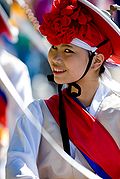Pungmul
Pungmul is a Korean traditional music. It includes drumming, dancing, and singing. Most performances are outside, with tens of players, all in constant motion. Pungmul is rooted in the dure farming culture. It was originally played as part of farm work, on rural holidays, at other village community-building events, and in shamanistic and Buddhistic rituals. Pungmul performers wear very gorgeous costumes. A flowery version of the Buddhist kkokkal is the most common headdress. Advanced performers sometimes wear sangmo, which are hats with long ribbons attached to them that players can spin and flip in intricate patterns by moving their heads.
Drumming is the most important element of Pungmul. Each group is led by a kkwaenggwari (small handheld gong) player, and includes at least one person playing janggu (hourglass drum), buk (barrel drum), and jing (gong). Wind instruments (t'aepyongso and nabal) are sometimes played along with the drummers. Following the drummers are dancers, who often play the sogo (a small drum that makes almost no sound) and tend to have more elaborate choreography. Finally, japsaek (actors) dressed as caricatures of traditional village roles wander around to engage spectators, blurring the boundary between performers and audience. Minyo (Korean traditional chants) are performed in Pungmul sometimes, and audience members enthusiastically sing and dance along. Most Minyo are set to drum beats in one of a few jangdan (rhythmic patterns) that are common to Pungmul, Sanjo, P'ansori, and other traditional Korean musical genres.





